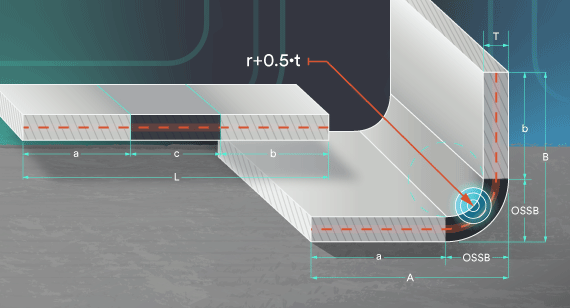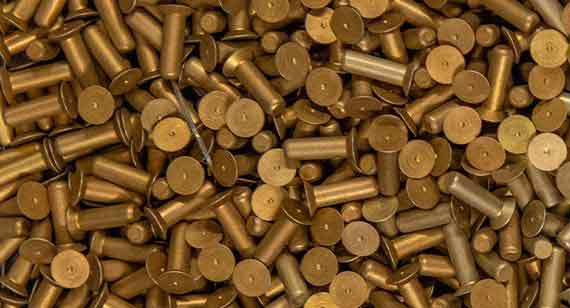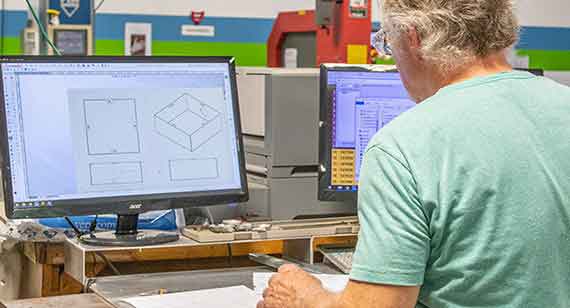Sheet metal fabrication is considered a lower cost method for manufacturing certain types of parts. It’s simple, right? You cut the sheet to size, and form it to reflect the desired geometries. But here’s the deal: If you get more obscure with your designs, the costs can quickly go from bargain bin to premium price tag. Then, your low-cost part quickly becomes a luxury item made of humble sheet metal. You might also end up increasing manufacturing time. Sheet metal fabrication is a labor-intensive process, so part cost is mostly a function of how many operations your manufacturer must perform in order to make your parts.
Often, it makes sense to aim for the simplest design solution, when your specifications permit. Here are 11 helpful tips to ensure that your sheet metal parts meet your needs and don’t break the bank.

1. Consider Plating, Welding Costs for Sheet Metal Fabrication
Let’s start with this premise: Pre-plated sheet metal can’t be welded safely. When you super-heat the treated metal, the coatings release zinc oxide, a highly toxic compound that vaporizes into gas. Ultimately, that’s not good for workers, or the environment.
If welding is required, you have one choice. Use uncoated cold rolled steel. Afterward, you can get your parts coated to enhance anti-corrosion properties. The downside to this is that it will definitely increase your lead times and cost.
Instead, take a close look at your designs and see if there are ways to avoid welding. If you do that, you can use pre-plated steel. If joining sheets is critical, consider using rivets.
2. Bending the Curve: Optimal Bend Radius for Sheet Metal Parts
One of the easiest ways to save money and time is to incorporate geometries in your part designs that consider a manufacturer’s standard tooling. For example, internal bend radii should always be between 0.030 in. (0.762mm) and material thickness. These specifications tend to be in the wheelhouse for most shops. They will be able to form your radii with tools specifically made for these specs, rather than having to use a specialized toolset or an alternative method to get that precise geometry.

3. Choosing Materials and Finishing Sheet Metal Parts
These two go together. To start, aluminum (6061-T6 or 5052-H32), steel (CRS1008), and stainless steel (304-2B) are common sheet metals that are always in stock, so you’re less likely to incur a special order fee from your manufacturer. Right there, you’ve saved money and time.
But choosing a material isn’t just about cost. If your parts will be in a hostile environment, choosing pre-plated metals makes a lot of sense. The exception, as mentioned earlier, is that you can’t use pre-plated materials such as galvanized and galvannealed metals if you need a welded seam.
Also, some materials are, by their very nature, less likely to corrode. If you do require a special finish, it might not set you back too much. There are common finishes that tend to be faster and less expensive.
Anodizing, chromate plating, zinc, stainless steel passivation, and powder coat are all readily available and will have a minimal impact on cost and lead time compared to a specialty finish.
Another reason to use more common materials and finishes is speed. Going with specialty materials and finishes requires estimators to source out external quotes, which adds lead time.
4. Avoid Elaborate Design Elements for Sheet Metal Fabrication
This is probably the easiest and most obvious of the tips to help you cut costs on sheet metal parts. Specialized design elements might look great, and sometimes there are good reasons for them, but taking them out of your models and aiming for simplicity is good practice. If you have to keep a careful eye on your budget, adding features such as machined pockets, blind holes, and chamfered edges could drive up costs and lead times. That said, chamfers, for example, give a nice finished look to your sheet metal parts and can limit the chance that users will injure themselves on sharp metal edges.
5. Be Flexible with Your Sheet Metal Designs
When you include punch-form features in your designs, such as bridge lances, embossments, and ribs, aim for standardized sizes to avoid manufacturing delays and added cost. If you do need very specific dimensions for these features, you should include that information in your RFQ by saying so in your model. For example, let’s say you request a bridge lance that is 0.100 in. (2.54mm) tall, 0.100 in. (2.54mm) wide, and 0.625 (15.875mm) in. long. Simply changing two of those dimensions to 0.090 in. (22.86mm) wide and 0.600 in. (15.24mm) long will put you into in-house tooling, reducing costs and time. You might discover suggestions like this if you get a China Metal Parts Proposed Revision (PPR) back from us.

6. Avoid the TMI Syndrome with Sheet Metal Design
You would be surprised how often we receive models that are filled with all sorts of data we don’t need to know. Typically, it’s something like details on hardware unrelated to the part we’re manufacturing for you. These are factors that may be critical to the overall assembly, but if your manufacturer isn’t involved in it in any way, it’s clutter that can slow down the estimating and manufacturing process. A good rule of thumb is that you should suppress any details in your models that aren’t pertinent to your manufacturer. Imagine putting in what you think is a request for one part, but getting billed and receiving two parts back. Surprise! So, this small rule can make a big difference.
7. Stick with Fast, Frugal Fasteners for Sheet Metal Parts
Ordering fancy fasteners is a sure way to drive up costs and slow down manufacturing. It’s always best to stick with fasteners that are readily available, such as those in the PEM catalog. Its website has a solid inventory search tool that can let you know which suppliers/vendors have stock for any given PEM hardware item. Also, if you are looking for aluminum or 400 Series stainless steel hardware, it’s important to know that inventories can be inconsistent. PEM can supply these, but generally you’ll face a 10,000-piece minimum order and six to eight weeks of added lead time to get your special hardware. That means that you might have a whole lot of hardware lying around your warehouse that you might never need—an expense that could prove substantial.
8. Simplify Sheet Metal Parts with Off-the-Shelf Hardware
Let’s say you want an assembly that includes built-in elements intended to hold specific components. One example might be card guides to hold circuit boards. Manufacturers can fabricate those guides in the sheet metal itself, but that takes a lot of time, and card guides are incredibly expensive tools costing more than $1,000. Instead, source your press fit card guide and adjust your design to accept the new component. Placing the guides is always in your team’s court, but the overall cost and time savings are undeniable when you create features that accommodate standard, off-the-shelf components.
9. Include Hardware BOMs: Details that Ensure Accurate Sheet Metal Parts
Manufacturers can do a lot of wonderful things for you, but mindreading is not among them. Whenever you send a quote, make sure to include a hardware Bill of Materials (BOM). If you provide the precise name for the hardware you plan on using, our systems can look up those parts and, for example, create the perfect threads to accept a screw. BOMs can be included in prints, or in separate Word or Excel documents. You can even include them in the comments section. You can also use a BOM to refer to specific finishes, materials, and other requirements. Having this knowledge in hand means we don’t have to exchange a series of emails, slowing down the path to you getting your parts in hand. So, if time is money and accuracy is important to you, adding these notes is a smart idea.
10. Consider Delaying Silkscreening or Engraving for Sheet Metal Parts
If you’re in the early prototyping stages of product development, seeing the look of certain finishes on your parts may not be important to you. Instead, consider delaying finishes like silkscreening and engraving until later.
When you’re ready to explore various finishes, remember that silkscreening is expensive, but a whole lot more affordable than machine engraving. Sure, engraving is long-lasting, but the cost might make it impractical. Want to add permanence to your silkscreened elements? Try applying a clear powder coat to seal and cover that information. It will add time and cost to your parts, but may save you money in the long-term.
11. Follow our Suggestions to Cut Sheet Metal Costs
When you get a quote back from us, you will receive a detailed design analysis to improve the manufacturability of your parts. That helps, but it won’t necessarily make your parts less expensive.
So, if we see ways to save you money, we will also include PPRs free of charge. Basically, if there’s an opportunity to reduce sheet metal fabrication costs by improving the manufacturability of your design, the PPR will let you know right in the quote by outlining how much time and money you could save. These might include changes to designs such as using standardized bend radii or other basic adjustments to geometries or material. You have the choice to take our suggestions, or not. Just know that we have your back when it comes to best pricing.
For additional help, feel free to contact one of our applications engineers at +86-755-27311095 or [email protected]. To get your next design project started today, simply upload a 3D CAD model for a quote within hours.
